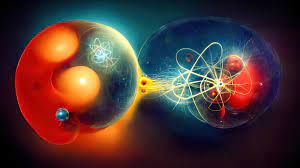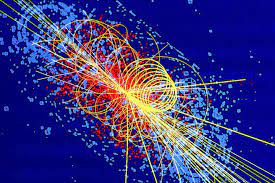Discovering the Fundamental Particles.
Humans have always been interested to know the fundamental building blocks of all matter. In very early times, it was believed that all matter was made up of the classical elements: Fire, Water, Earth, and Air. Then, in 585 BC, the Greek philosopher Democritus suggested that matter is built from small, solid, hard, uniform, incompressible, and indivisible particles called 'Atoms
The atoms were accepted as indivisible until, in 1911, Rutherford performed his experiment and proved that the atom also contained sub-atomic particles. He discovered that atoms had a positively charged heavy nucleus around which negatively charged particles, called Electrons, revolve. Later came Bohr's atomic theory which suggested that electrons revolve around the nucleus in quantized orbits.
In 1932, James Chadwick discovered that along with the positively charged protons, the nucleus contained neutral particles, which he named neutrons.
Later in the 20th century, physicists theorized the existence of substructures of nucleons (protons and neutrons) named 'quarks.' Experimental evidence supporting the existence of quarks began to accumulate in the following years through particle accelerators.

Standard Model of Elementary Particles
The Standard Model Of Particle Physics.
The standard model of particle physics is a theoretical table that describes the fundamental particles and the forces that govern their interaction. It basically contains all the fundamental particles that make everything around us and they themselves are not made up of any particle. These particles are called Matter Particles or Fermions. The standard model also contains force carrier particles called bosons. Bosons of 3 of the 4 fundamental forces of physics are included in the table.
The Standard Model explains how these particles interact through the four fundamental forces: electromagnetic, weak nuclear, strong nuclear, and gravity. It provides a comprehensive understanding of the subatomic world and has been supported by numerous experiments and observations.
Details of each of the group of particles are here under.

1.QUARKS
Quarks are the tiniest building blocks of matter that we know of in particle physics. They are incredibly small, making up the protons and neutrons found in the nucleus of an atom. Think of quarks as the "pieces" that combine together to form larger particles. There are six known types of quarks: up, down, charm, strange, top, and bottom. Each type of quark has a unique set of properties. For example, up and down quarks are the most common and makeup protons and neutrons. One fascinating aspect of quarks is that they cannot exist alone. They always combine together to form particles such as protons or mesons, which are made up of quark-antiquarks pairs.
Protons are made up of 2 up and one down quark whereas neutrons are made up of 1 up and 2 down quarks
Instead of having a whole number charge, quarks have fractional charges which add up to the charge of the particle they form. It is measured in the units of elementary charge(e). The first three quarks; up, top, and charm, have a fractional charge of +2/3 e, and the other three; down, bottom, and strange, have a charge of -1/3 e
proton has 3 quarks: 2 up and down, hence its charge is: +2/3 +2/3-1/3 = 3/3= 1. Neutron has 2 down and an up quark, so its charge is: -1/3-1/3+2/3 = 0/3 = 0.

2.LEPTONS
Leptons are a group of fundamental particles in particle physics. They are the building blocks of matter, just like quarks. They include particles like electrons and neutrinos
The electron is a type of lepton that orbits around an atom's nucleus and carries a negative electric charge. It is responsible for electricity and the way atoms bond to form molecules. Neutrinos, on the other hand, are very tiny and have no electric charge There are several types or flavors of lentons. In addition to the electron,there are muons and taus, which are heavier versions of the electron
Neutrinos, on the other hand, are very tiny and have no electric charge. They are extremely elusive particles that can pass through matter without interacting much. Each type of lepton has an associated neutrino. For example, the electron has an electron neutrino, the muon has a muon neutrino, and so on.

3.Bosons
Bosons are a type of particle in particle physics that play a different role compared to quarks and leptons. While quarks and leptons are the building blocks of matter, bosons are particles that carry forces and mediate interactions between particles.
One well-known boson is the photon, which is a particle of light. Photons carry electromagnetic force, allowing for interactions between charged particles. They are responsible for everything we see and the transmission of information through light and other forms of electromagnetic radiation.
Another important boson is the W and Z bosons, which carry the weak nuclear force This force is involved in processes like radioactive decay and plays a crucial role in the Sun's energy production. The strong nuclear force, which holds atomic nuclei together, is mediated by particles called gluons. Gluons are also bosons
One particularly significant boson is the Higgs boson. Its discovery in 2012 was a major breakthrough in particle physics. The Higgs boson interacts with other particles and gives them mass, playing a fundamental role in our understanding of why particles have mass.



You must be logged in to post a comment.